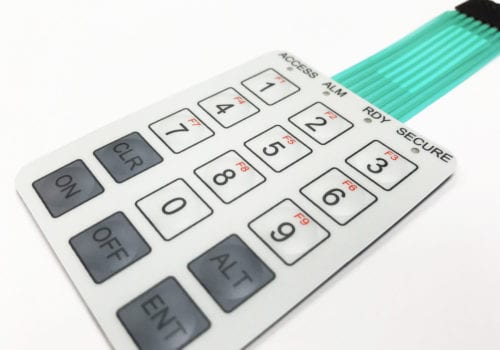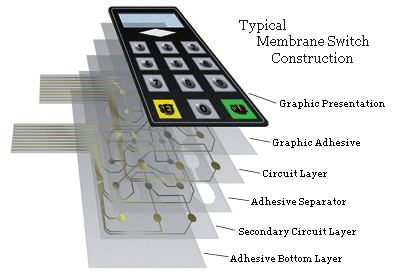All About Membrane Layer Switch Over: Recognizing Its Style and Capability
When you think about the control interfaces in contemporary tools, membrane layer buttons typically enter your mind. These elements are much more than just switches; they mix layout and functionality effortlessly. Recognizing exactly how they function and what makes them efficient can change your viewpoint on everyday electronic devices. Yet, there are nuances to their layout and performance that you could not know. Let's discover what collections membrane switches over in addition to other control systems.
What Are Membrane Layer Buttons?

Their seamless nature makes them very easy to tidy and resistant to dirt and moisture, an essential function in numerous environments. Membrane buttons can likewise be personalized regarding shape, dimension, and graphics, permitting manufacturers to create unique interfaces tailored to particular items. And also, they're light-weight and thin, which assists in reducing the total bulk of devices. In general, membrane layer switches play a considerable function in boosting customer experience throughout a wide variety of applications.
Exactly How Membrane Changes Work
When you push a key on a membrane button, it triggers a straightforward yet effective mechanism. The top layer, commonly constructed from versatile product, lowers onto a conductive layer below it. This activity bridges the space in between conductive traces, finishing an electrical circuit. As quickly as the circuit shuts, it sends out a signal to the gadget's controller, which analyzes your input.
You'll discover that the tactile responses varies based upon the button design, using either a soft click or a more noticable response. Once you release the trick, the membrane layer go back to its initial setting, reopening the circuit and quiting the signal. This procedure happens nearly instantly, guaranteeing a responsive individual experience.
Membrane layer buttons are prominent due to their longevity and resistance to dust and wetness, making them ideal for different applications, from house appliances to clinical tools. Understanding this operation aids you appreciate their prevalent usage.
Trick Parts of Membrane Buttons
Comprehending the key parts of membrane switches is fundamental for understanding their functionality and design. At the core, you'll discover the graphic overlay, which offers the visual interface for users. Below that, there's a spacer layer that separates the circuit layers, making sure that they do not make get in touch with until pushed. The circuit layer is where the magic happens; it is composed of conductive traces that complete the circuit when you push the switch. One more crucial element is the glue backing, permitting the button to comply with surface areas firmly. The safety layer shields versus environmental factors and wear, expanding the switch's life-span. Each part plays a significant role in making sure trusted performance and user interaction. By comprehending these components, you'll acquire understanding into exactly how membrane changes operate and their value in different applications.
Materials Utilized in Membrane Layer Change Layout
The performance and resilience of membrane layer switches over heavily depend on the materials used in their style. You commonly experience polyester and polycarbonate as main substratums due to their excellent stamina and flexibility. These products withstand scratches and chemicals, making them suitable for demanding atmospheres.
The conductive layers usually use silver or carbon, picked for their dependability and conductivity. membrane switch manufacturer. Silver gives remarkable performance, while carbon is a cost-efficient option. For the overlay, you could consider a matte or shiny surface, relying on your aesthetic needs and user experience
Adhesives play an essential duty as well; they bond layers safely and guarantee durability. Make certain to select adhesives that endure environmental elements like temperature and moisture. Lastly, don't forget the value of a great printing strategy for graphics, as it improves both capability and aesthetic charm. Selecting the best materials will certainly assure your membrane button stands the test Check This Out of time.
Layout Considerations for Membrane Layer Switches
While developing membrane switches, it's important to consider different elements that influence their performance and individual experience. Begin by concentrating on the format and switch size; make sure they're instinctive and very easy to browse. Think about the responsive comments you desire to give-- will individuals require an obvious click or a softer touch? Additionally, think of the products you'll utilize, as they'll affect toughness and aesthetic appeals.
Don't ignore the visuals layout; clear labeling and shade contrast are substantial for visibility. Verify your design suits ecological elements, like wetness or temperature level variations, which might impact performance. Bear in mind the significance of testing models with real users to gather feedback and make required adjustments. This iterative procedure aids you refine the style, confirming it satisfies both functional and aesthetic needs properly. By very carefully taking into consideration these elements, you'll develop a membrane layer button that improves use and complete satisfaction.
Applications of Membrane Layer Switches
Membrane layer switches are flexible parts located in numerous applications, from industrial equipment to consumer electronics. You'll see their influence in devices that require durable interfaces and in gadgets that profit from smooth designs. Recognizing these applications assists you value the functionality and usefulness of membrane layer buttons in everyday innovation.
Industrial Equipment Use
When you're aiming to enhance the performance of industrial tools, membrane layer switches use a trustworthy option that incorporates resilience with straightforward style. These switches are excellent for rough environments, supplying resistance to dust, moisture, and chemicals. You'll locate them in control panels for making makers, heating and cooling systems, and clinical devices, where accuracy and responsiveness are vital. Their reduced account indicates they fit seamlessly right into numerous equipment, conserving useful space while keeping convenience of use. With personalized graphics and backlighting options, you can Find Out More develop an user-friendly interface for operators, enhancing efficiency and security. And also, their long life-span reduces upkeep prices, making them a smart financial investment for your industrial applications. Accept membrane layer buttons to streamline your procedures and improve overall performance.
Customer Electronic Devices Integration
In the domain name of customer electronic devices, membrane switches play a crucial role in improving customer interaction and tool functionality. You'll discover them in gadgets like microwaves, remotes, and pc gaming consoles, offering a smooth way to interact with technology. Their smooth style permits simple assimilation into different items, making controls instinctive and user-friendly. With their ability to incorporate graphics and backlighting, you can delight in a modern aesthetic that matches the gadget's general appearance. Membrane layer buttons additionally assure durability and resistance to dust and moisture, extending the lifespan of your electronics. By choosing membrane switches, you boost not just the capability yet additionally the design of your gadgets, making everyday interactions smooth and pleasurable.
Benefits and Drawbacks of Membrane Layer Buttons
While membrane layer switches provide an array of advantages, they also come with some drawbacks that you should consider. One significant benefit is their small style, making them ideal for space-constrained applications.

Membrane layer switches can have a shorter life expectancy contrasted to mechanical switches, especially under heavy usage. They can likewise be less tactile, which may affect user comments throughout procedure. Stabilizing these pros and cons will help you establish if membrane layer switches are the right fit for your job.
Often Asked Concerns
How Much Time Do Membrane Changes Usually Last?
Membrane layer switches over commonly last between 5 to one decade, depending on usage and ecological conditions. You'll intend to examine variables like wear, direct exposure to dampness, and temperature level changes to evaluate their longevity effectively.
Can Membrane Layer Changes Be Customized for Specific Styles?
Yes, you can customize membrane layer buttons to fit details styles (membrane switch manufacturer). You'll have the freedom to choose colors, forms, and designs that match your task's requirements, guaranteeing they mix perfectly with your overall aesthetic
What Is the Expense Variety for Membrane Switch Production?
The expense array for membrane layer switch manufacturing usually falls between $1 and $10 each, depending on variables like design complexity, amount, and products. You can obtain quotes from manufacturers to locate the finest option.

Are Membrane Layer Switches Water-proof or Immune?
Membrane buttons can be created to be water-proof or immune, depending on materials made use of and building approaches. If you need them for damp atmospheres, ensure you investigate this site specify those needs throughout the style process.
How Do Membrane Layer Switches Over Contrast to Traditional Switches?
Membrane layer buttons are usually thinner and a lot more flexible than standard switches, using a sleek layout. They're typically simpler to clean up and integrate, but could not supply the tactile responses you're made use of to with mechanical alternatives.
Final thought

Comments on “Many businesses depend on a skilled membrane switch manufacturer for custom solutions.”